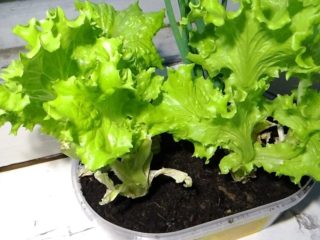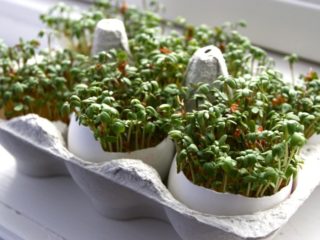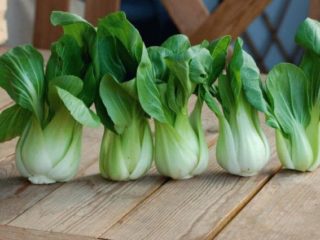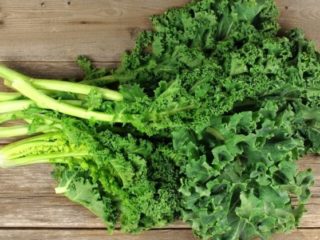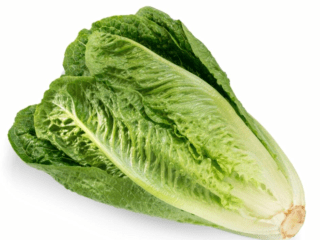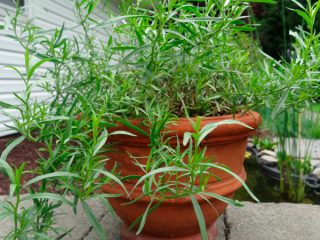Content
Growing lettuce in a greenhouse is an activity that can be done all year round. This crop does not require special care, simple agricultural technology, and grows quickly. Many people grow it commercially and receive good income from it, especially in the cold season. Even a small, well-equipped greenhouse allows you to make good money.
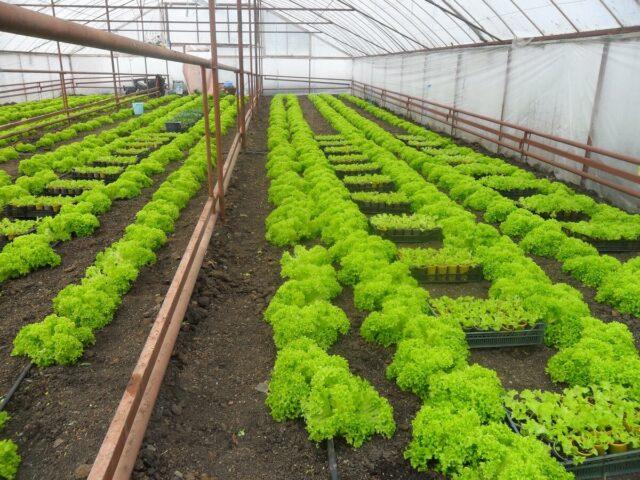
Lettuce, which is grown indoors, grows rapidly, brings a large harvest and almost does not get sick
Choosing a salad variety
The culture is represented by a huge number of varieties. Almost all of its varieties are suitable for growing in greenhouse conditions, but most often gardeners give preference to early-ripening representatives of class 1 plants. They have high yields, good taste and ripen quickly. It is better to choose leafy varieties, the harvesting of which involves cutting off the leaves while the root system of the plants remains in the ground.Often, for growing indoors, lettuce Aficon, Balet, Dubrava, Kitezh, Odessa Kucheryavec Odesskiy, Tornado are chosen.
Sometimes in the greenhouse they grow half-headed varieties. They are characterized by a raised rosette of leaves, in the center of which a head of cabbage forms during the growth stage. Such varieties have an average growth rate and are usually cultivated from seedlings. The following types are more suitable for greenhouses: Berlin yellow (Berlinskiy Jeltiy), Stone heads (Kamennaya Golovka), Festival (Festivalniy).
There are also head varieties of lettuce with a longer ripening period. They are demanding in terms of care, lighting and other conditions. Common ones are Iceberg, Azart, and Crispy.
Red-leaved varieties of crops are in high demand among individual gardeners. The color of their green mass turns brown due to weather conditions. They acquire interesting colors in a cool microclimate.
Greenhouse requirements
Growing lettuce in a greenhouse will be effective if all requirements for the planting site are met. Before cultivating a plant indoors, it is important to study the features of this method of producing greens.
The room in which lettuce will be grown must meet the following requirements:
- High quality material. To keep the greenhouse warm in winter, the structure must be reliable, preferably standing on a foundation. Its size is chosen based on the purpose of cultivation.It will not be possible to harvest a large harvest from a small area, but a spacious greenhouse will take a long time to pay for itself. For a small business, a structure of 8-10 square meters is quite enough. Its optimal size is 500x200. You can choose the covering material: film, polycarbonate, glass, for the frame: metal, wood.
- Good heating. It is most convenient to use infrared heating devices to warm up the greenhouse. In addition, a wood-burning stove can be installed indoors. Mulch and agrofibre will help maintain the temperature well.
- High-quality watering. When growing lettuce in greenhouse conditions, it is especially important to ensure regular watering with warm and clean water. The best option is a drip irrigation system.
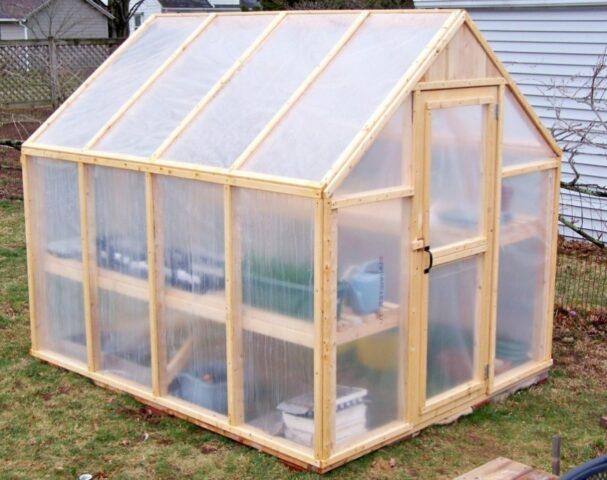
Some people make greenhouses with their own hands
How long does lettuce grow in a greenhouse?
If the crop is grown under properly created conditions and in compliance with all recommendations, then in the greenhouse the lettuce ripens quite quickly to a size suitable for consumption. After the emergence of seedlings, it takes about 22 days to harvest a harvest with good taste.
The yield of lettuce in greenhouses per m2 also depends on the variety and care. On average, it is possible to collect from 1.5 to 2 kg of greenery per square meter.
When to plant lettuce
You can sow lettuce seeds in closed ground almost all year round. If planting is done in September, the harvest can be harvested until January. Some gardeners plant crops immediately after the New Year holidays; in this case, fresh greens are cut before mid-March.If the structure is not heated, then the plant is grown from the second half of March until the last days of April (the exact timing depends on the climatic characteristics of the region).
Seedlings of the crop are usually planted in greenhouses at the age of a month. A few days before the work, they begin to harden it, for which they take it out of the house into a greenhouse for several hours, gradually increasing the time it stays there.
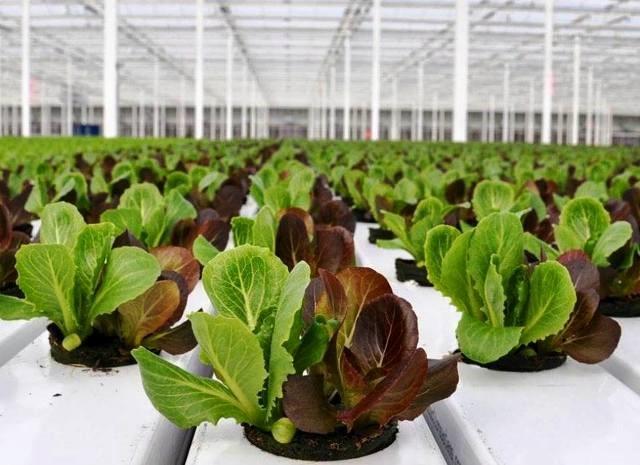
The salad is in especially high demand during the winter holidays.
How to grow lettuce in a greenhouse in winter
Growing lettuce leaves in a greenhouse is not a particularly labor-intensive process, which, in principle, can be done even by people who do not have special knowledge of agricultural technology. The main thing in the process is to create suitable conditions for planting, as well as to organize proper care throughout the entire growth.
Preparing for sowing lettuce in a greenhouse
Growing healthy greens in a greenhouse involves a number of preparatory work. Lettuce seeds are small, so they are planted in loose soil without lumps. Before work, it is recommended to fill the beds with organic fertilizers (peat, humus, sand), and also treat them with disinfectants (sprinkle with boiling water or potassium permanganate). It is useful to add 40 g of superphosphate and 15 g of potassium chloride for each meter of area.
Scheme of planting lettuce in a greenhouse
Typically, to plant lettuce in a greenhouse, gardeners follow the following instructions:
- The soil is loosened and moistened.
- They make grooves in the beds with a width between rows for leaf varieties of at least 20 cm, for cabbage varieties about 35-45 cm.
- The planting material is deepened by 8-10 mm.
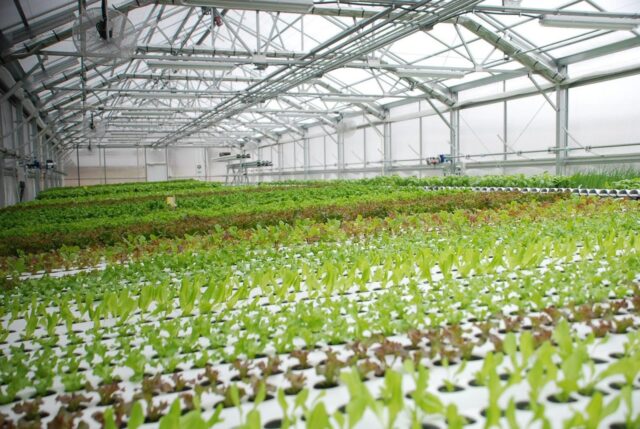
After germination, it is especially important to monitor the microclimate in the greenhouse
Aftercare
Lettuce grown indoors does not require a large number of care procedures. All recommendations can usually be read on the package with the plant seeds. The plantings are watered every other day until the shoots appear, and after the sprouts appear on the surface of the ground, the frequency of watering is reduced to twice a week. In this case, warm water is used; it is advisable to use the drip method of humidification. The procedure is performed at the root, trying not to get on the foliage. The row spacing is loosened about once a month. When growing plants in a greenhouse in sunny weather, they are opened and ventilated, but at the same time avoiding drafts. Attention should also be paid to the lighting of the beds. If the salad lacks light, it will begin to stretch. If daylight hours are short, additional lamps will have to be installed in the greenhouse. As for the temperature regime, the culture loves warmth, but does not perceive heat particularly well. During the day in the greenhouse it should be about +17-20 °C, at night +10 °C. Lettuce reacts well to fertilizers. Potassium chloride, urea, and ammonium nitrate are perfect for feeding.
Diseases and pests
When growing lettuce in a greenhouse, you may encounter some diseases and sometimes pests.Most often, this crop is subject to fungal diseases that arise due to the use of contaminated seeds or soil, as well as failure to comply with the watering regime. Young lettuce is at greatest risk. Common ailments include: downy mildew, rot, blackleg.
As for pests, aphids like to attack the crop, and special means are used to combat it. Lettuce can also be attacked by slugs and lettuce flies.
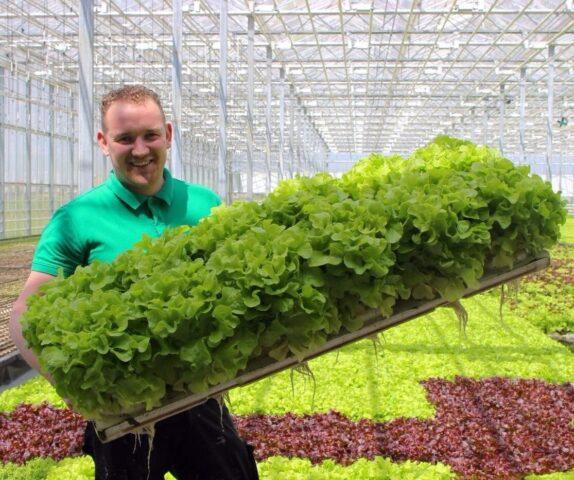
To protect plantings, it is recommended to follow agricultural practices and perform disease prevention
Harvesting
When growing lettuce in a greenhouse, gardeners begin harvesting the crop at the moment when the leaves of the plant reach a length of approximately 9 cm. If the crop is a cabbage variety, then it is cut after the head of cabbage has fully developed. It is not recommended to water the lettuce before carrying out work, as this has a negative impact on the storage and presentation of the product. Also, harvested greens cannot be washed.
Experienced gardeners note that it is better to cut lettuce leaves early in the morning or in the evening. They must be loosely and neatly placed in boxes and sold as soon as possible. When cultivating lettuce under closed conditions, its shelf life is about one and a half days.
Conclusion
Growing lettuce in a greenhouse can be done all year round, and by creating suitable conditions for the crop, as well as proper care, excellent results can be achieved in this matter. Lettuce is a very useful plant, widely used in cooking, and for some dishes, especially holiday ones, it is an indispensable ingredient.Growing lettuce in a greenhouse as a business is not a bad idea. Since the crop is not particularly demanding and ripens quickly, it can bring a good income to the gardener.
